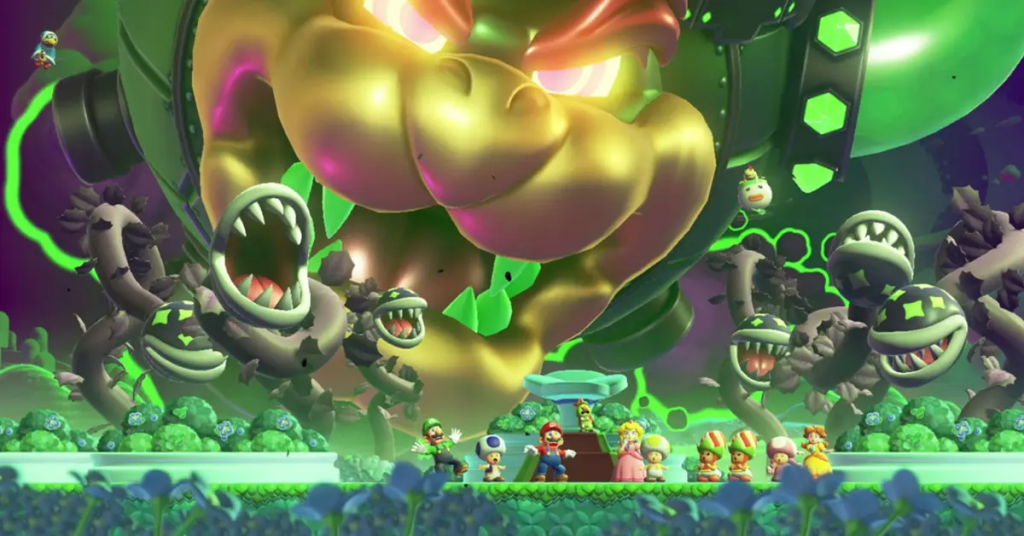Being the first 2D side-scroller since New Super Mario Bros. U in 2012, Super Mario Bros.’ Wonder has been an anticipated release for months. With a promise of innovative game mechanics in its trailers, Wonder seemed to set high expectations for itself from the start.
While the game has gotten some backlash for straying from the modern classic, it truly encapsulates the whimsical adventure of OG Mario games while crafting the style and gameplay of a masterpiece.
However, since there are so few, the pitfalls of the game are worth addressing. To start, Wonder doesn’t greatly expand on the beloved storyline of Mario games. Essentially, Bowser arrives in Flower Kingdom, wreaking havoc by stealing the wonder flower — the source of chaotic magic in the realm. Alongside the Poplins, inhabitants of the Flower Kingdom, your character’s goal is to take Bowser down. This works fine as Mario games typically aren’t plot-centric, but Wonder had a lot of unskippable cut-scene dialogue that bogged down the gameplay.
Secondly, Wonder is not very challenging, especially for repeat gamers and fans of the franchise. The levels seem shorter than in previous installments, and while there is some variability in level difficulty, many are able to be completed in one or two attempts.
Finally, the coin systems are too complex and not implemented properly. In the most recent Mario side scrollers, the only coins are of the gold and star variety, but Wonder takes these and adds purple coins and royal seeds. Purple coins buy things but are too common to be of any mechanical importance, while royal seeds are functionally indistinguishable from the wonder seeds that players win after each level. Thus, this new format relies on using wonder seeds to buy final levels, making tracking seed amounts quickly tedious.
However, these very wonder seeds also supply the game with the essence needed to fulfill its promise of fun, adventure and whimsy. When you find the first wonder seed in each level, they distort the world into something weird and unexpected, adding a whole new dimension of gameplay. Some examples include Mario being turned into a slime ball, made to swim through lava, stuck in an inverted version of the 2D perspective and plunged into inky darkness.
In fact, the new mechanics as a whole stand out as some of the most alluring parts of the game. Wonder allows players to jump up on rhythmically boosted platforms, slip over slime, push and move pipes (sometimes against a mob that’ll push back) and interact with flowers that, in a sparkle of light, reveal coins, platforms or wonder seeds. New power-ups allow you to hit mobs with your trunk or spray water onto wilted flowers as an elephant, use bubbles to trap mobs and make poppable platforms or drill under the earth to get to hard-to-reach places.
The new “badges,” which replace the traditional power-up reserve in past games, allow players to jump super high, throw vines to grab onto ledges, swim fast as a dolphin or 13 other options. Although this aspect could’ve been executed better, it still exhibits the dazzling new approach to gaming that makes Wonder different from any of its predecessors.
Furthermore, the game expands upon the typical “capture the flag” level type to include different methods of gameplay for a more dynamic experience. “Search Party” incorporates a rewarding puzzle-solving aspect while “Badge Practice” levels are a fun way to practice new skills. The racing game is simple and refreshing while KO arenas are a cool way to show off new mobs and introduce more achievement-based combat.
Speaking of mobs, there were at least 14 new types of fun and creative creatures to tangle with. Hoppycats are spiky and get in the way of players by mimicking their jump, mumsies are tall mummies with a string that unwraps them when pulled, hoppos are big balloon-like hippos that can push players back or make them jump higher and friendly flowers are scattered all across the levels making silly comments and adding a layer of cohesive humor to the experience.
Lastly, the most notable triumph of Wonder is the design and animation. Wonder has absolutely stunning visuals that captivate the player and really live up to the title. Meanwhile, the animation of this game is so thoughtful and humorous, adding to the general quirky vibe. For example, Mario reaches back for his hat when he goes through pipes, mobs’ eyes bulge when they run away, goombas have snot bubbles while they nap and elephant Mario squeezes himself through small doors and pipes. This attention to detail is especially commendable as a testament to the love, care, dedication and time that must’ve gone into this game’s creation.
All in all, Super Mario Bros. Wonder is truly an aesthetic innovation that combines the best aspects of past 2D Mario scrollers with revolutionary creative flourishes, crafting a thrilling and joyous romp. Not to mention, the introduction of online play, a “Secret” World and levels that weren’t needed to beat the central game all build up the game’s replayability. Overall, although the game isn’t perfect, Wonder delivers on its promise of fun, colorful creativity and wonderful gameplay for a riotous success.
Rating: 8/10



